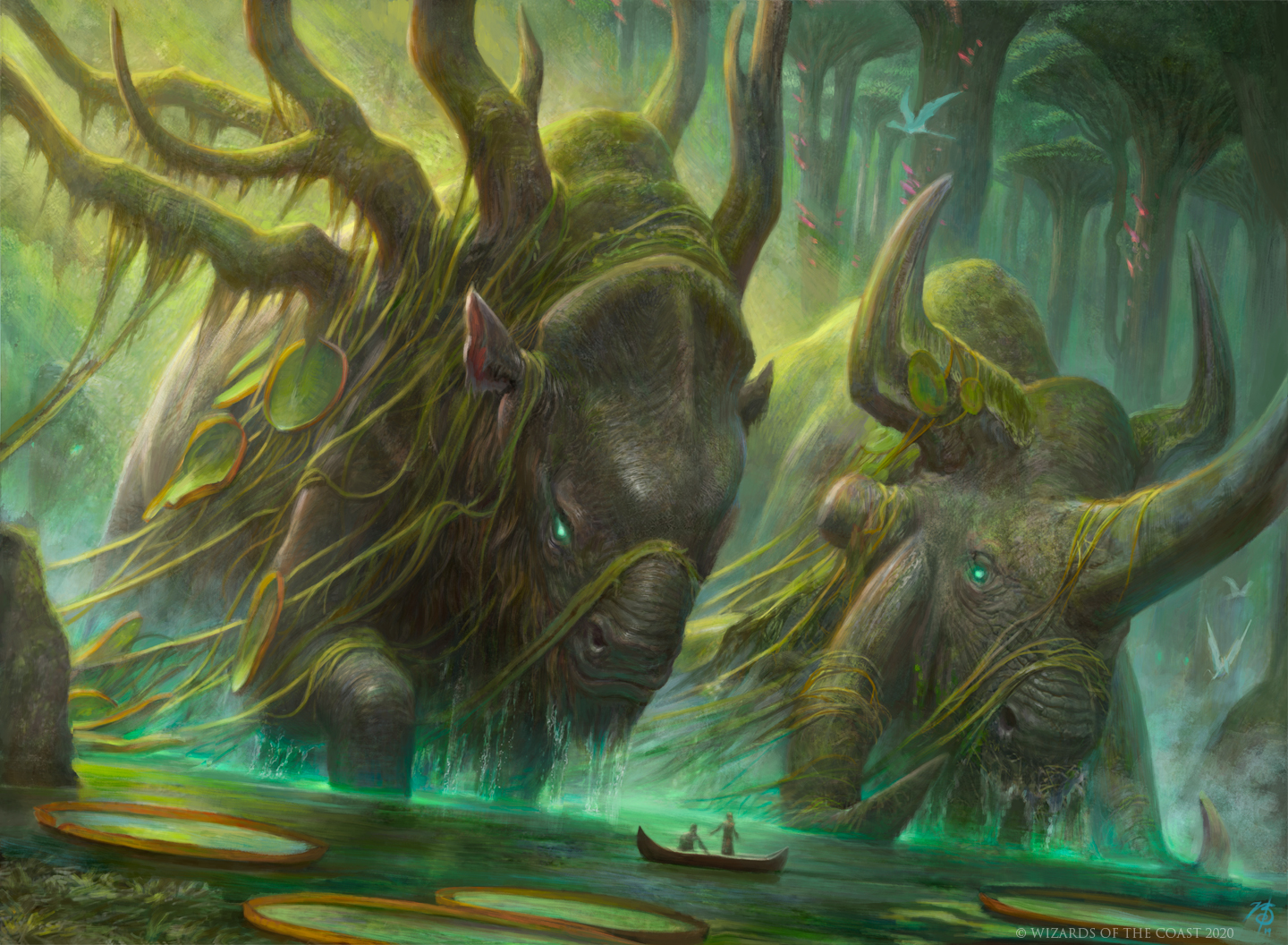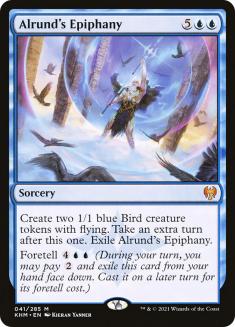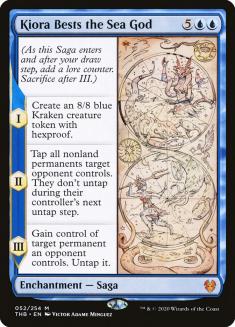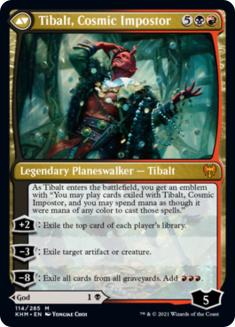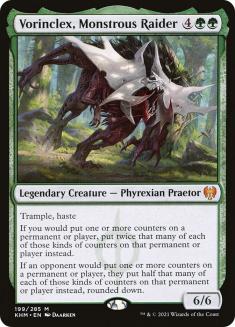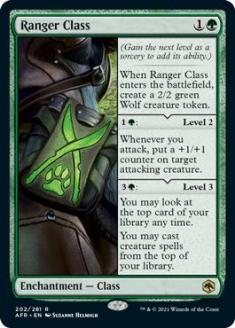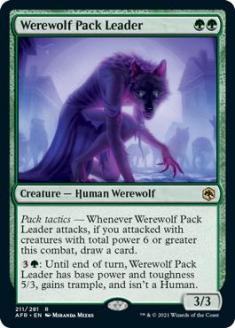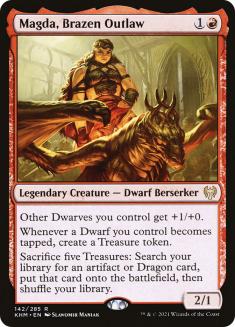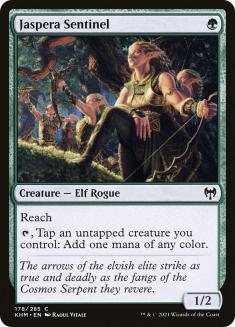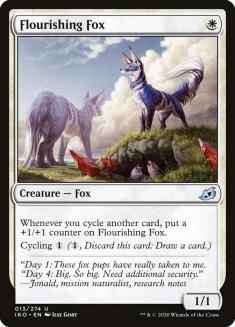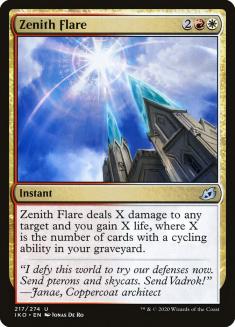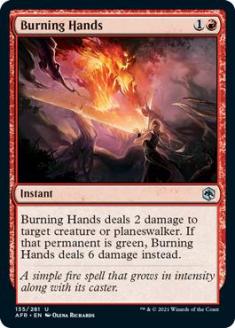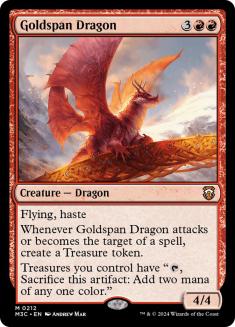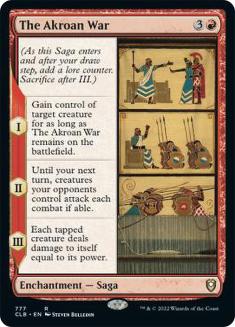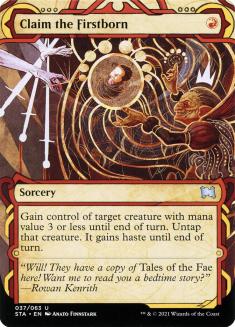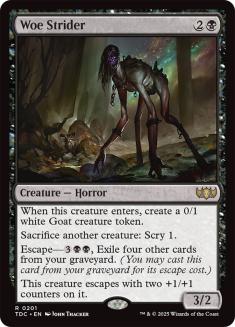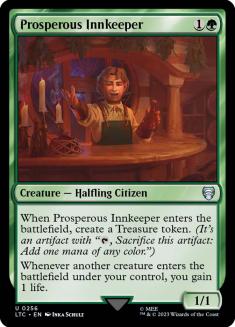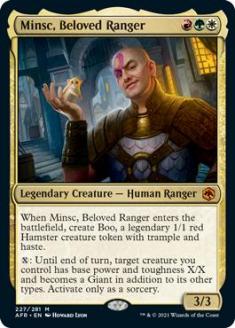Adventures in the Forgotten Realms Standard is a wide-open format, and there are many decks that you can play and do well with. Today I’m going to split the best decks into three tiers and give my reasons for why I think these decks are particularly good or bad right now.
Tier 1
Tier 1 decks are the ones that I believe are always going to be a good choice. They’re inherently powerful and do not require a particular metagame to succeed.
Sultai Ramp (Yorion)
Creatures (8)
- 2 Polukranos, Unchained
- 3 Elder Gargaroth
- 1 Vorinclex, Monstrous Raider
- 1 Valki, God of Lies
- 1 Quandrix Cultivator
Lands (31)
Spells (41)

- Good versus: Decks that can’t pressure you very well (Naya Adventures, Rakdos Sacrifice, Izzet Dragons❄).
- Bad versus: Aggro decks with disruption (Mono-White Aggro❄, Dimir Rogues).
As a general rule, Sultai Ramp (Yorion) is very much in the middle with its matchups. Few matchups are very good or very bad (in fact I would argue that not a single matchup is very bad, which is one of the biggest strengths of this deck). The Izzet Dragons❄ matchup in particular is a point of contention, but given that in theory it seems like it should be good for you and in practice I beat the deck most times I play it, I feel comfortable saying I think it’s a good matchup.
As I mentioned in What We’d Play: Standard this week, I think Sultai Ramp is a boring yet effective answer to the rest of the field. In simple terms, this is a Sultai control deck with a pseudo-combo kill that requires only one card — Emergent Ultimatum. When you play it, you usually get a combination of Alrund’s Epiphany; Kiora Bests the Sea God; Valki, God of Lies (or in this case Tibalt, Cosmic Impostor); and Vorinclex, Monstrous Raider, and that’s enough to win the game from most positions. It doesn’t literally win the game like a Splinter Twin combo would, but I would estimate it wins the game in over 90% of spots.
This deck is currently very strong, and the reason is the combo kill paired with control elements. Normally, when you’re playing against a control deck, one possible avenue to win the game is grinding your opponent out, but against this deck that is very hard to do, because they have this “I win” button. So, for example, cards like planeswalkers or Ranger Class aren’t as strong here as they would be against a traditional control deck. This leaves “killing them quickly” as the best plan of attack, but Sultai Ramp is a black deck that has access to cheap spot removal and sweepers, as well as Elder Gargaroth.
Elder Gargaroth allows this deck to attack aggro and midrange opponents from a completely different angle than the rest of the deck, and is good versus most things that are good versus your traditional gameplan, such as fast beatdown and specific disruption spells in the form of Duress, Negate or Mystical Dispute. In fact, in some matchups (such as Jeskai Cycling and Izzet Dragons❄) you often become an Elder Gargaroth deck post-sideboard, using your own Duresses to make sure you resolve it. This presents an interesting challenge to your opponents because Elder Gargaroth demands an answer, but answers to Elder Gargaroth are mostly bad versus the entire rest of your deck and you’re an 80-card deck, so there’s no guarantee you’ll ever even draw it.
All in all, this is my pick for strongest deck in Standard.
Mono-Green Aggro
Creatures (29)
- 2 Scavenging Ooze
- 4 Lovestruck Beast
- 1 Questing Beast
- 4 Stonecoil Serpent
- 4 Gemrazer
- 4 Swarm Shambler
- 4 Kazandu Mammoth
- 2 Old-Growth Troll
- 4 Werewolf Pack Leader
Lands (23)
Spells (8)

- Bad versus: Sultai Ramp
Mono-Green Aggro is the new kid on the block, and it’s perhaps the only truly new deck to have found its way into the top tiers of the format. It’s not entirely new, as several versions of the deck have existed in the past, but the deck simply wasn’t competitive before Adventures in the Forgotten Realms and now it definitely is.
This is due to mainly two cards — Ranger Class and Werewolf Pack Leader. The green decks always struggled with two-drops, often having to play suboptimal cards just to fill their curve, and now it has access to two very good ones.
Ranger Class is one of the best cards in Adventures in the Forgotten Realms (if not the best card), and it’s a Luminarch Aspirant / Vivien, Monsters’ Advocate hybrid, allowing you to commit something to the battlefield and at the same time giving you the tools to beat sweepers and removal spells. Werewolf Pack Leader is not as novel but it’s just an incredibly strong beater compared to what we previously had on the format.
Another meaningful card that the deck got is Lair of the Hydra. These aggressive decks love creature-lands (especially their ability to beat sweepers), and now we have one that produces green mana. I talked to Willy Edel, who played the deck in question, and inquired about a couple of Faceless Havens in addition to the Lair of the Hydras, and he agreed that they could be good. Originally he had four copies of Old-Growth Troll so he didn’t want the colorless land, but as he cut down on those maybe some Havens could be added.
I think Mono-Green Aggro is bad versus Sultai Ramp, which puts a cap on how good it can actually be (since I think Sultai Ramp is both the best and the most popular deck), but it should be strong versus most other things.
Gruul Adventures
Creatures (27)
- 4 Lovestruck Beast
- 4 Edgewall Innkeeper
- 4 Bonecrusher Giant
- 4 Rimrock Knight
- 4 Magda, Brazen Outlaw
- 3 Goldspan Dragon
- 4 Jaspera Sentinel
Lands (19)
Spells (14)
Sideboard

- Good versus: Anyone when you have good draws, but most red-based decks
- Bad versus: Anyone when you have bad draws, but mostly Sultai Ramp
After about eight months of hitting #1 on the Arena Ladder, Raphael Levy’s deck finally seems to have gained some traction and is now firmly the most popular version of Gruul. The main difference from previous versions is that it eschews the landfall creatures (Brushfire Elemental, Kazandu Mammoth) and instead focuses more on speeding up Goldspan Dragon with Magda, Brazen Outlaw and Jaspera Sentinel.
The deck also has a bunch of synergies that previous Gruul decks didn’t have. Magda and Sentinel are themselves synergy (since you can always tap Magda for mana to make a Treasure, even the turn you cast it), and Esika’s Chariot works with Magda in two different ways (it can also tap Magda and the Treasure is a token for you to copy). Goldspan Dragon also works with all the Treasures, and if you hit five of them, you can sacrifice them to search up Magda or Goldspan Dragon.
The price you pay for those synergies is that the power level on your cards is a bit lower than usual. Jaspera Sentinel is not the world’s best beatdown creature, and Magda is much worse than something like Brushfire Elemental at actually killing them. If you have a bad draw or if you’re disrupted, you might simply not have enough raw power to win the game, but your good draws feel truly busted.
Another cool thing about this deck is that, since you have Treasure makers and Jaspera Sentinel, splashing a color is not very hard. In this decklist, Jacob Wilson, the person I based my list on, splashed blue for Disdainful Stroke, which is probably the best card versus Sultai Ramp since it deals with both Emergent Ultimatum and Elder Gargaroth. I believe this is the way to play the deck moving forward.
Jeskai Cycling
Creatures (15)
Lands (20)
Spells (25)

- Good versus: Non-base-red aggro decks (Mono-White Aggro❄, Naya Adventures)
- Bad versus: Embercleave, Elder Gargaroth, Elspeth’s Nightmare
Jeskai Cycling is a bit of a puzzle because it’s always underrepresented but always overperforms. You’d think a deck that consistently hits 55% in tournaments would be played more, but it’s always the same people playing it and no one else. I think part of the reason is that the deck is frankly a bit boring to play. The only excitement you have is whether you have Turn 1 Flourishing Fox or not and whether you’re going to topdeck Zenith Flare to kill your opponent or not. On top of that, the deck has also gotten like one relevant card in the past two years, which means people aren’t rushing to play it.
Still, it can be a strong choice, and I would consider it part of Tier 1. The thing with Cycling is that it doesn’t necessarily have bad matchups in terms of decks, but more so in terms of cards. A white-based aggro deck is very easy to beat, but an Embercleave-based aggro deck is much harder. Sultai Ramp can be very easy or very hard, depending on the composition of their deck. In this regard, it’s a bit similar to Dimir Rogues — if people want to beat you, they have the tools to do so. But if people do not want to beat you, your deck is really good.
Tier 2
The Tier 2 decks are all competitive, and I don’t think you’re making a big mistake playing them. However, they’re a little bit worse than the Tier 1 decks to me, or they might require a specific metagame. Still, don’t necessarily be dissuaded by my ranking of a deck as Tier 2.
Izzet Dragons❄
Creatures (16)
Lands (26)
Spells (18)

- Good versus: Small aggro decks (Mono-Red Aggro❄, Mono-White Aggro❄)
- Bad versus: Sultai Ramp, predicting the wrong metagame
I wrote about Izzet Dragons❄ a while ago here, and my opinion hasn’t really changed — it’s a deck I didn’t love before, but I believe some new tools (especially Burning Hands) can catapult it to the top tiers of the format. For now I still have it in Tier 2, but it wouldn’t surprise me if it became Tier 1 anytime soon as people iterate on the new versions of the deck.
Izzet Dragons❄ looks like a midrange deck, with cheap disruption spells, some card drawing, and the Dragons to close out the game, and it plays like this sometimes (especially against the super-aggro decks). Against other midrange and control decks, however, it plays a bit like a combo deck — you want to set up turns where you have a battlefield and then cast one or two Alrund’s Epiphanies and just kill them.
The biggest issue with this deck is that a lot of your cards are binary and work against one type of deck and not the other. Frost Bite and Dragon’s Fire are good versus creatures and horrible versus control, and the opposite is true for Negate, Disdainful Stroke, and Mystical Dispute, so if you misjudge the metagame or if you draw the wrong half of your deck, you’re going to be in trouble. If you draw the right half of your deck, though, your deck has the tools to beat anything.
Mono-Red Aggro❄
Creatures (27)
- 4 Robber of the Rich
- 4 Fervent Champion
- 4 Bonecrusher Giant
- 3 Torbran, Thane of Red Fell
- 3 Rimrock Knight
- 4 Anax, Hardened in the Forge
- 1 Phoenix of Ash
- 4 Hall Monitor
Lands (25)
Spells (8)
Sideboard

- Good versus: Non-green decks
- Bad versus: Green decks
Mono-Red Aggro❄ gained an important sideboard card (Burning Hands again), but other than that it remains about the same as it was before — it’s still not good versus green decks, but it’s at least better versus them than it was before.
This is a very straightforward aggro deck, and while it’s strong and certainly a playable choice, I’m of the opinion that it’s not as good as Gruul Adventures. Burning Hands goes a long way towards solving your problems, though, and if it drives Lovestruck Beast and Elder Gargaroth out of the metagame, this deck could move to Tier 1, but a surge in the popularity of Mono-Green Aggro is probably going to keep this deck in check regardless.
Other than Burning Hands, this deck also gained Den of the Bugbear, which I believe is an improvement over the previously played Castle Embereth, but the general idea of the deck remains the same.
Mono-White Aggro❄
Creatures (31)
- 3 Giant Killer
- 4 Alseid of Life's Bounty
- 4 Seasoned Hallowblade
- 4 Selfless Savior
- 4 Speaker of the Heavens
- 4 Luminarch Aspirant
- 2 Reidane, God of the Worthy
- 4 Elite Spellbinder
- 2 Blade Historian
Lands (24)
Spells (5)

- Good against: Sultai Ramp, Mono-Red Aggro❄
- Bad against: Naya Adventures, Dimir Rogues, Rakdos Sacrifice
Mono-White Aggro❄ has remained about the same. In fact, this particular list has absolutely no new cards in it. Still, the Selfless Savior + Luminarch Aspirant + Maul of the Skyclaves core is very strong, and this deck retains the ability to kill people very quickly while also disrupting them with Elite Spellbinder and Reidane, God of the Worthy.
This particular list is a bit different from normal in that it plays Speaker of the Havens, which I don’t like very much. I kept the list because it was the most up-to-date one I found and it illustrated my point about there being no new cards, but I would recommend swapping the Speakers for something else.
Naya Adventures (Jegantha)
Creatures (30)
- 4 Lovestruck Beast
- 4 Giant Killer
- 4 Edgewall Innkeeper
- 4 Bonecrusher Giant
- 2 Drannith Magistrate
- 4 Clarion Spirit
- 4 Jaspera Sentinel
- 4 Elite Spellbinder
Lands (23)
Spells (7)

- Good against: Red-based decks
- Bad against: Sweepers, its own manabase
Naya Adventures is what you get when you take Gruul Adventures and remove some aggressive elements for more grindy cards. Between Giant Killers, Elite Spellbinder, and Showdown of the Skalds, it has a lot more interaction and more staying power but it also can’t kill nearly as quickly.
Personally, I don’t like this deck. In fact, if it wasn’t so popular I might move it to Tier 3, but I’m compromising with the hive mind and putting it in Tier 2, because there are a lot of people who do well with it. All in all, though, this deck has never seemed very powerful to me, and a lot of its draws are very clunky because of its manabase. You need a lot of green and white and some red mana, and you have no lands that produce more than one color once on the battlefield, so sometimes you have three lands out but can’t cast two one-drops.
Other than that, the deck is especially vulnerable to sweepers, and here it can basically be dealer’s choice of sweeper, since it dies to all of them. This means it has a bad matchup versus Sultai Ramp, for example, which is not a great place to be unless you beat everything else. I’m not saying you can’t play Naya Adventures — you definitely can — but I think it’s currently the most overrated deck in Standard.
Tier 3
Tier 3 decks are decks that I believe you should not play unless you know the metagame is particularly right for them. They’re not as powerful as the top decks or have too many natural enemies, so you need to make sure you know what you’re walking into. They’re still playable, but I would avoid them if I were going to a tournament blindly, and I don’t think they’re great ladder decks unless the metagame gets really warped.
Rakdos Sacrifice (Jegantha)
Creatures (20)
- 4 Bonecrusher Giant
- 4 Woe Strider
- 4 Mire Triton
- 2 Kroxa, Titan of Death's Hunger
- 2 Valki, God of Lies
- 4 Immersturm Predator
Lands (24)
Spells (16)

- Good against: Creature decks
- Bad against: Non-creature decks
Rakdos Sacrifice is another deck that seemed to have made a resurgence. It’s relatively popular in online tournaments even though it also hasn’t gained anything new (this version is only playing three creature-lands as new cards, for example).
Rakdos Sacrifice is a quintessential midrange deck — it has several mid-sized creatures and a bunch of removal spells. The deck is very strong against other creature decks, since it can combo Claim the Firstborn or The Akroan War with one of many sacrifice effects to steal creatures regardless of size, making it particularly effective against Mono-White’s stat boosts.
The problem with this strategy is that, if the opponent doesn’t have creatures, you don’t really do anything because your own creatures are not the best at pressuring the opponent. This means something like Sultai Ramp is a pretty bad matchup.
Naya Winota
Creatures (35)
- 4 Lotus Cobra
- 2 Kenrith, the Returned King
- 4 Bonecrusher Giant
- 4 Winota, Joiner of Forces
- 4 Selfless Savior
- 2 Maja, Bretagard Protector
- 4 Elite Spellbinder
- 4 Prosperous Innkeeper
- 4 Ochre Jelly
- 3 Minsc, Beloved Ranger
Lands (23)
Spells (2)
Sideboard

- Good against: Decks with no instant-speed removal (Mono-White Aggro❄, Mono-Green Aggro)
- Bad against: Redcap Melee, Sultai Ramp, Naya Adventures
I was always a big fan of Boros Winota, but with the advent of Prosperous Innkeeper and Minsc, Beloved Ranger, the Naya version seems to finally have become the more standard (Standard?) one.
Prosperous Innkeeper is a non-Human that accelerates into Winota and helps fixing for the three-color deck, and Minsc, Beloved Ranger is effectively both a Human to hit and a non-Human to trigger Winota.
The biggest problem with this deck is that the hits are not thaaaat great. You’re running a lot of small creatures that might just throw themselves at blockers to get Winota triggers, but you usually need more than one since there aren’t many hits that are good by themselves. In a Boros version, your creatures are usually a bit more resilient, so you don’t lose your attacker to get, say, an Elite Spellbinder. Still, this deck is a ton of fun.
Dimir Rogues (Lurrus)
Creatures (16)
Lands (22)
Spells (22)

- Good against: Clunky decks, Mono-White Aggro❄
- Bad against: Mono-Red Aggro❄, sideboard cards
Dimir Rogues consists of cheap creatures with flash that mill your opponent and a bunch of milling payoffs, and it can win the early- or the late-game. It used to be a very powerful deck, but it has fallen out of favor due to complete stagnation. Most of its slots were already taken and it can’t play anything new, in part due to being a Lurrus of the Dream-Den deck. Once the best deck in the format, Dimir Rogues has watched for months as other decks get better and better, to a point it’s no longer that good. It used to be that you could play this into any field, but now you need a particularly good metagame to justify it.
Even then, I feel like the sideboard cards for Dimir Rogues are not at an all-time high. It used to be that every red deck would have three Ox of Agonas and a couple of Phoenix of Ash, every green deck would have Chainweb Aracnir, and so on. The current number on these cards isn’t zero, but it’s one to two. If at some point it gets to zero, maybe Dimir Rogues will be good again, so it’s an interesting deck to keep in mind.
There are many decks that I haven’t included in these lists (for example Temur Lukka, all non-Sultai control decks, and so on), but I think the ones I did include are your best bets if you want to do well on ladder or at tournaments. Adventures in the Forgotten Realms Standard is still quite new and there might be some new decks that will surprise me.
Personally I am hoping for that, as I can’t stand playing Sultai Ramp anymore, but also can’t really justify anything else.

